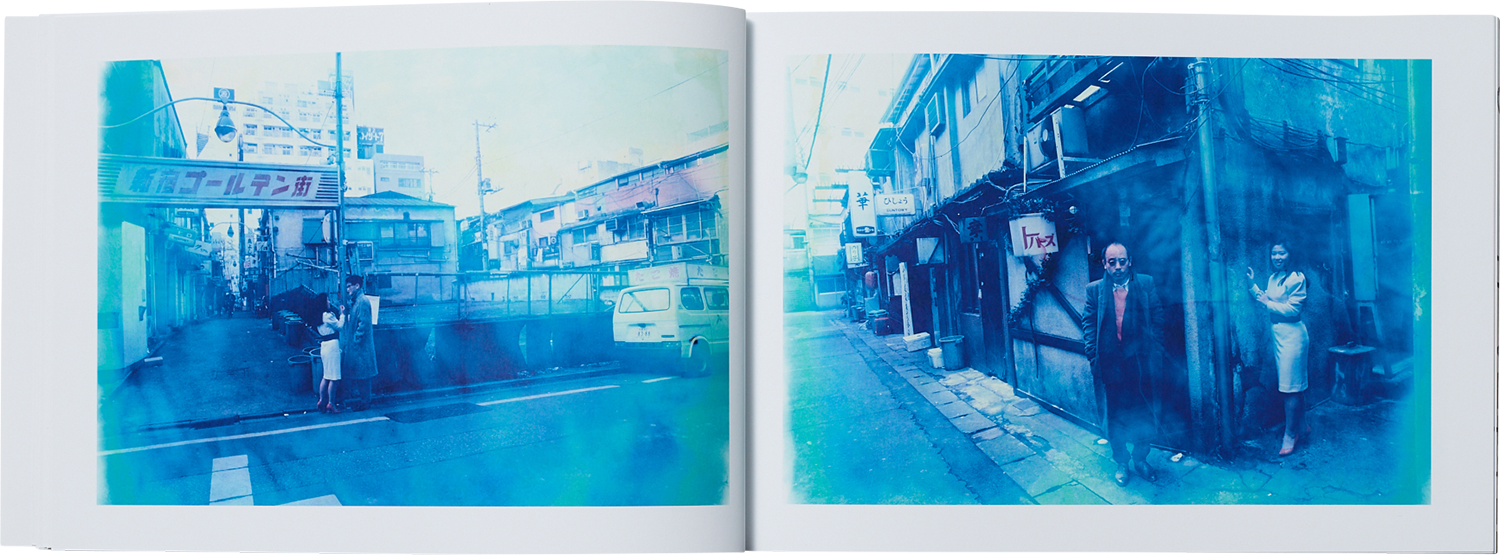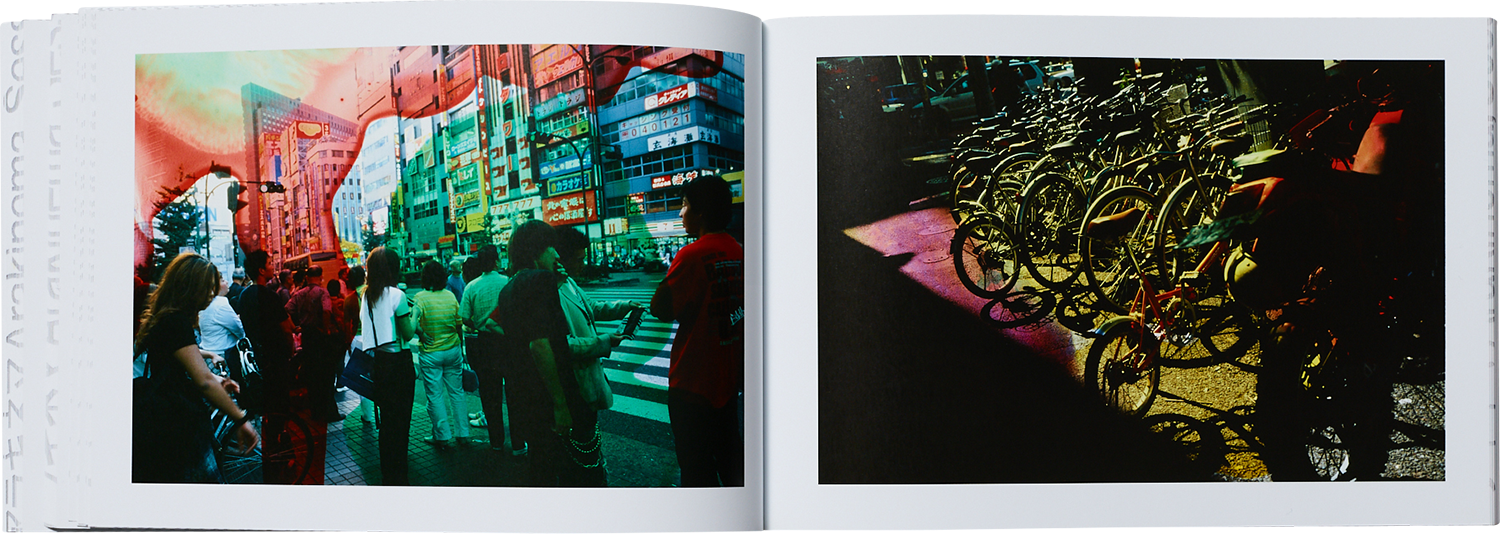—Photography: Nobuyoshi Araki
—Design: Geoff Han, NYC
—Text: Marc Feustel
—Editor: Keenan McCracken
—Japanese translation: Akiko Ichikawa
—English translation: Tomo Morisawa
—Production Assistant: Wanki Min, Yoshiaki Miura, & Mitsuyo Okada
—Lithography: Sebastiaan Hanekroot, Colour & Books
—Image Scanning: Shashin Kosha Inc., Tokyo
—Production: Jos Morree, Fine Books
—Printer: Gra Plaza, Amsterdam
—10.23" x 7"
—Softcover in slipcase
—Edition of 1750
—2017
One of the most influential photographers of our time, Nobuyoshi Araki is known for his diaristic style or ‘shi-shashin’ (I-photographs) through the publication of over 500 books throughout his career. His work has become practically synonymous with Japanese photography; closely associated with his work on bondage, his late wife, Yoko, as well as still lifes and nudes.
It is, however, less known that Araki had explored experimental film projects since the mid 80s. In 1986 at Cinema Rise in Tokyo, Araki staged a live performance entitled “Tokyo Monogatari” (Tokyo Story). Using two projectors, Araki and his assistants, Nobuhiko Ansai and Shiro Tamiya, selected and sequenced slides to create a succession of overlapping images fading into one another, accompanied by a musical soundtrack. “Tokyo Monogatari” became the first in a series of live performances entitled Arakinema, which he staged until the mid-2000s in museums and art institutions around the world. “Blue Period” and “Last Summer” are made up primarily of nudes and portraits alternating with street scenes and images of flowers. The majority of the work is derived from “Shashin Jidai”, the important underground subculture magazine of the 1980s in Japan.
We especially feel excited about our publication since these two projects are essential among his film work. As Araki also explained at our initial meeting in Shinjuku last year, “The two films should be seen as a set, since “Blue Period” is about the past and “Last Summer” is about the future. By removing color using a chemical solution, “Blue Period” is about an act of subtraction (past), whereas adding color to the images in “Last Summer” is about an act of addition (future). This project is just like life itself.”
Working directly from the 140 original slides used for both projections, the book successfully offers a fresh review of the photographer’s hidden oeuvre and regains the true spirit and atmosphere of the original Arakinema performances
日本人写真家、荒木経惟の作品集。本作は、作者の映像作品「アラキネマ」に焦点を当てた写真集として、NY を拠点 とする出版社、SESSION PRESSとDASHWOOD BOOKSから共同出版されました。日本国外でこの映像作品『青ノ時 代』『去年ノ夏』を出版物として発表するのは初めてとなります。 作者は「私写真」と称して自身の日常をありのままに撮影した写真作品を制作し、これまで 500 冊以上の写真集を 出版してきました。特に、緊縛、今は亡き妻陽子、花などの静物写真、ヌードは代表的な作品として国内はもとより海外でも広く名が知られていますが、80 年代中期から約 20 年間、実験的な映像作品「アラキネマ」を制作し、ライブ上映してきたことは詳しく紹介されていません。
本写真集では、ライブの臨場感や雰囲気をできるだけ忠実に再現するために、両作品が上映 された際のオリジナルスライドに基づいて編集、制作しました。『青ノ時代』『去年ノ夏』はともに 2005 年に発表された作品であり、前者は 1980〜90 年代に雑誌『写真時代』に掲載された作品でまとめられている一方、後者は 2005 年前後に 撮り下ろされた作品が使用されています。 ヌードとポートレートを軸にしながら、街路の風景や花の写真なども併せて構成された両作品に共通しているのは、オリジナルの写真に手を加えることで力強い効果を生み出しているという点です。『青ノ時代』では薬品で脱 色することで引き出された色褪せたブルーが、まるで夢か消え去っていく記憶の中にでもいるかのような、メラン コリックな儚さを作品にもたらしています。また『去年ノ夏』は明るく透明感のある色を写真の上に塗っていくこと で、まるで万華鏡が映し出す幻想的な世界を表現しています。
作家自身も両作品が過去と未来を現す人生そのもので あり対にして見られることをインタビュー(アートン:東京、2005 年)の中で語っています。
(アラキネマについて)
スライド写真に音楽をつけて投影するライブパフォーマンスであり、第1作の『東京物語』は、東京・渋谷にあった シネマライズで 1986 年に上映されました。その後、ライブパフォーマンスとしての「アラキネマ」はセセッション館 (ウィーン)、原美術館 、スパイラルホール、読売カルチャーサロン青山、台北市立美術館、東京都現代美術館、パレ・ ド・トーキョー(パリ)、バービカン・センター(ロンドン)など世界各国の美術館や関連施設で 90 年代後半から 2000 年代半ばにかけて企画、上演されました。
1991 年からは「アラキネマ」のコンセプトを映像作品として残すために、映像制 作を手がけるクエスト社より 2010 年までに 30 本の作品を発表してきました。これらはライブパフォーマンスと同じ手 法をとり、スライド写真をオーバラップさせながら投影し、フリーフォームの即興音楽が添えられ、ライブで味わう 臨場感に溢れた構成で制作されています。
Artist Statement
—The two (blue period/last summer) works look very different.
They do! I’d say Last Summer is the future; it has a certain sense of resignation about it.
Blue Period is the past, because it’s about how memory inhabits us. But we don’t yet have a memory of the future. You had better get both of them [laughter]. That’s right! Seriously. They are awesome. They knock me out. The red you see in Last Summer is red of blood. And the blood must be shed. Blue just won’t cut it. It would just seem off. I’d say [Last Summer] surpasses Mizoguchi’s Ugetsu Monogatari.
—It reminds me of the faded tones of old movies on VHS.
True. When we watch those movies, we watch them with the already lost tones. The original is forever gone. The same can be said of ancient temples like Horyu-ji. Restoration kind of kills its beauty, as I’m convinced old shrines and temples were designed with the weathering away of colors over time in mind. It makes them more interesting. Blue Period, too, goes all the way back to the beginning. In a way, my path as a photographer was laid out for me thanks to everything that happened before that. You know, when we look at Atget’s photobooks, what we are looking at are the faded tones of countless reproductions. We can’t see as Atget actually saw back then. But we still look at the pictures seriously and as real things.
These two works are my tour de force, really. They’re great.
Interview with Nobuyoshi Araki
At Rouge in Shinjyuku, July 2005
(Translation: Tomo Morisawa)
Araki Nobuyoshi, “Blue Period” (Tokyo: Artone, 2005), pp. 163–165.
Nobuyoshi Araki
(Tokyo, 1940)
Nobuyoshi Araki is a Tokyo-based photographer. Araki completed his studies at Chiba University’s Department of Photography, Printing and Engineering with a focus on the study of film and photography. His photographic project “Satchin” earned him the prestigious Taiyo Award in 1964, shortly after he had joined the advertising agency Dentsu, where he worked until 1972. At Dentsu he met his wife Yoko, to whom he paid homage in Sentimental Journey, a photographic record of their honeymoon published in 1971. Eros and thanatos (sex and death) has been a central theme in Araki’s work; an abiding fascination with female genitalia and women’s bodies in Japanese bondage, flowers, food, his cat, faces and Tokyo street scenes. His solo exhibitions include “Araki,” Musée National des Arts Asiatiques Guimet, Paris (2016); “Ōjō Shashū: Photography for the Afterlife – Faces, Skyscapes, Roards,” Toyota Municipal Museum of Art (2014); “Nobuyoshi Araki Photobook Exhibition: Arākī,” IZU PHOTO MUSEUM, Shizuoka (2012); “NOBUYOSHI ARAKI: Self, Life, Death,” The Barbican Art Gallery, London (2005); “Hana- Jinsei,” Tokyo Metropolitan Museum of Photography (2003); “Tokyo Still Life,” Ikon Gallery, Birmingham (2001); “Nobuyoshi Araki,” Stedelijk Museum voor Actuele Kunst, Gent (2000); “ARAKI Nobuyoshi Sentimental Photography, Sentimental Life,” Museum of Contemporary Art, Tokyo (1999); “Tokyo Comedy,” Wiener Secession, Vienna (1997); “Journal intime,” Fondation Cartier pour l’art contemporain, Paris (1995); “Akt-Tokyo: Nobuyoshi Araki 1971-1991,″ Forum Stadtpark, Graz (1992). Araki was a recipient of the Austrian Decoration of Honor for Science and Arts (2008) and the 54th Mainichi Art Award (2012).
荒木経惟
(1940年・東京生まれ)
1940年東京都生まれ。千葉大学工学部写真印刷工学科卒業後、電通に入社し写真部に所属する。1964 年、『さっちん』で第 1 回太陽賞を受賞。1971年、妻陽子との新婚旅行を写した『センチメンタルな旅』を限定1000部で自費出版。以降、妖艶な花々、緊縛ヌード、空景、食事、東京の街、飼い猫、様々な被写体から強烈なエロスとタナトスが漂う独特の写真世界を確立し、日本を代表する写真家として内外で高い評価を受けている。おもな個展に『Araki』ギメ東洋美術館(パリ、2016年)、『往生写集-顔・空景・道』豊田市美術館(2014年)、『荒木経惟写真集展アラーキー』IZU PHOTO MUSEUM(静岡、2012年)、『私・生・死 』バービカン・アートギャラリー(ロンドン、2005年)、『花人生』東京都写真美術館(東京、2003年)、『Suicide in Tokyo』ジャルディーニ・ディ・カステッロ(ヴェニス、2002年)、『Tokyo Still Life』イコン・ギャラリー(バーミンガム、2001年)、『Nobuyoshi Araki』ゲント市現代美術館(2000年)、『荒木経惟 センチメンタルな写真、人生』東京都現代美術館(1999年)、『Tokyo Comedy』ウィーン・セセション、(1997年)、『荒木経惟・私日記』、カルティエ現代美術財団(パリ、1995年)、『アクト・トーキョー1971-1991』フォルム・シュタットパルク(グラーツ、1992年)がある。日本写真協会・年度賞(1990年)、オーストリア科学・芸術勲章(2008年)、第54回毎日芸術賞・特別賞(2012年)、第 6 回安吾賞(2012年)を受賞。







